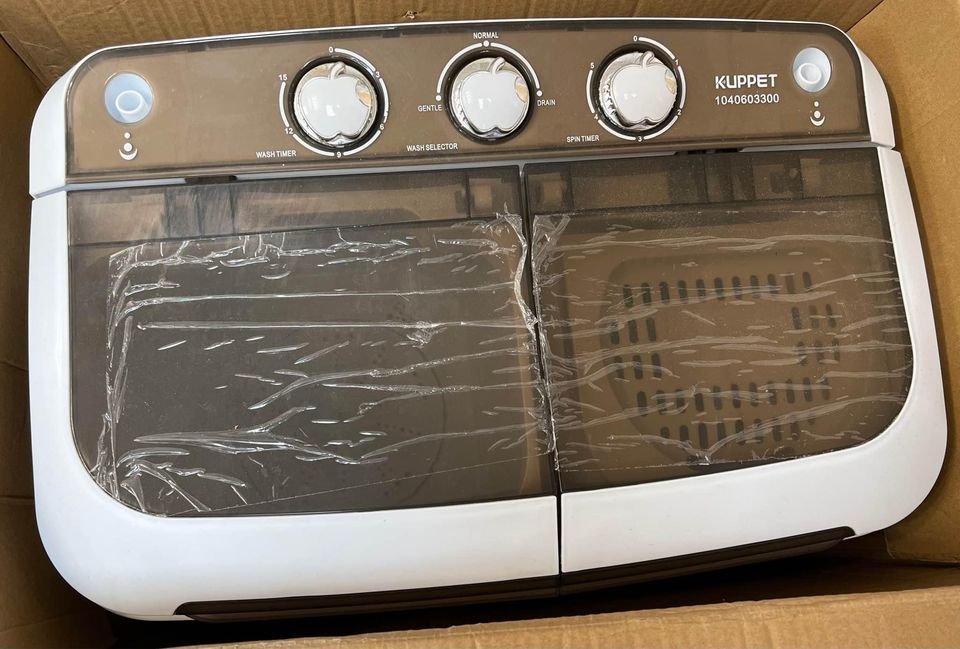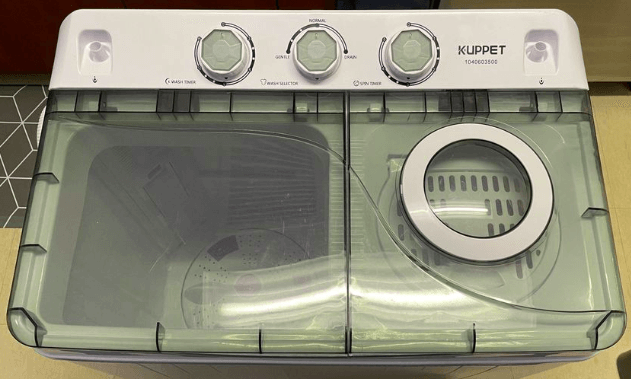Unlike regular washing machines, Kuppet portable washing machines require more effort and attention. However, don’t be alarmed as it is not a steep learning process. Once you understand the steps, washing your clothes with a portable washer becomes effortless.
Setting Up Your Kuppet Portable Washing Machine

Place your Kuppet portable washing machine next to a water and power source. The water source placement will aid in pouring water into the washer and draining the water afterward. The power source placement is obviously to power the washer.
There should be at least a 5 cm gap between the washer and a wall to prevent damage to your washer when it vibrates while spinning. Ensure the platform where you place the washer is sturdy.
Check the water intake pipe and the drainpipe, and fasten both properly to prevent water spillage.
Some recommend placing your portable washer near or inside a shower to eliminate water spillage.
Water doesn’t mix well with electricity, so ensure the power cord never gets wet.
Loading the Kuppet Portable Washing Machine

Next is loading your washer. You want to ensure not to overload the washing machine, which can result in mechanical errors or poorly done laundry.
Place the Clothes in the Kuppet Portable Washer
Kuppet portable washing machine comes in different sizes. Some have a 7 – 10-pound weight capacity, while others have up to 26 pounds weight capacity. Whichever size you have, ensure the amount of clothes you put in the washer is the right weight.
Putting excess weight into the washer prevents it from spinning and can cause damage.
Start with small loads, a few shirts, and dresses if you’re unsure of the weight capacity. Don’t forget to separate the white and colored clothes.
Before placing the clothes, remove any coins, pins, or metallic objects that can damage the washer. If the clothes have zippers and buttons, turn them inside out.
Fill the Kuppet Portable Washer with Water
Most Kuppet portable washers have two hoses: an inlet pipe and a drain pipe. You will connect the inlet pipe to a water source to fill the washer with water and drain the washer after the wash with the drain pipe.
When you want to start washing, hook your inlet pipe to your water source – usually a sink faucet – and fill your washer with water. Check your instruction manual to be sure you’re hooking up the correct hose.
If your washer doesn’t have an inlet pipe or if it doesn’t fit tightly to your faucet, use a bucket to pour water into the washer.
Before pouring water into the washer, place the drainpipe into a bucket, the sink, or the bathtub to prevent water spillage during the wash.
A line in the washer indicates the water level the washer has to carry. Exceeding this water level causes water spillage and damage to your clothes.
The water level depends on the size of your laundry load. Check your instruction manual for directions.
The water temperature you choose to fill up your washer, whether hot or cold, depends on the clothes’ care instructions.
Laundry Additives
Pour in a suitable detergent, preferably one that produces little soap suds. Use the right amount of detergent for your laundry load; so the clothes come out without residue, and the drain pipe doesn’t clog. Run another spin cycle if there are soap suds left.
Using fabric softener and bleach depends on the clothes you’re washing.
Washing with Kuppet Portable Washer

It is now time to get washing. These steps should help you do that effortlessly:
Plug the Kuppet Portable Washer
Plug your washer into a suitable power source after putting the clothes in the washer and filling it with water.
Make sure to plug your washer directly into the wall socket. Adapters and extension cords are not strong enough to carry the washer, so using these outlets can cause severe electrical damage.
Set the Wash Timer
Kuppet portable washers come fitted with a button(s) to indicate the amount of time given to a wash cycle. Set the timer at your discretion based on the number of clothes you have to wash, how dirty they are, and the material of the clothes.
Start the Washer
Ensure everything is in place, the socket, the water level, the detergent, etc. Turn on the start button to begin washing the clothes.
Drain the Kuppet Portable Washer
When the wash cycle ends, secure the drainpipe carefully in the sink, bathtub, or shower to prevent water spillage when you start draining the dirty water from the washer.
As always, check the instruction manual to be sure you are draining from the correct pipe.
Rinse the Clothes
After draining the dirty water from the washer, it is time to rinse the clothes.
Some Kuppet portable washers do not require a rinse cycle. If yours requires one, fill the washer with clean water and set your rinse time. Rinse the clothes until the water is clear.
Afterward, drain the water from the washer.
Spin Cycle
Kuppet portable washers have a separate smaller spin compartment. Place the washed clothes evenly into this compartment and set the spin cycle.
The spin cycle does a good job of removing most of the water from the wet clothes reducing the drying time.
When the spin cycle ends, drain the washer.
Repeat this process until you finish spinning the clothes.
Drying your Clothes
Hang your clothes on a drying rack, a clothesline, or a sturdy shower rod to air-dry. It will take a few hours to dry.
However, if you have a portable dryer, you can use it to dry your clothes.
